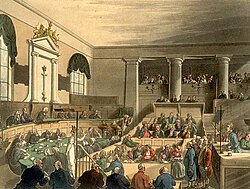Criminal law

The Old Bailey in London (in 1808) were more than 100,000 criminal trials between 1674 and 1834 were held, including all death penalty cases.
Criminal law is the part of law that is about social norms. People who violate these norms are punished for their violation.[1] It is different from civil law. Criminal law wants to protect certain values, such as life and limb, or property.
Criminal law has different objectives:
- Retribution – Criminals ought to suffer in some way. This is the most widely seen goal. Because of what they did, they profited from others, or they caused harm to them. As a consequence, criminal law will put criminals at some unpleasant disadvantage to "balance the scales". People submit to the law to receive the right not to be murdered and if other people act against these laws, they surrender the rights granted to them by these law. For this reason, one who murders may be executed himself. A related theory includes the idea of "righting the balance."
- Deterrence – Individual deterrence is aimed toward the specific offender. The aim is to impose a sufficient penalty to discourage the offender from criminal behavior. General deterrence aims at society at large. By imposing a penalty on those who commit offenses, other people are discouraged from committing those offenses.
- Incapacitation – Designed simply to keep criminals away from society so that the public is protected from their misconduct. This is often achieved through prison sentences today. The death penalty or banishment have served the same purpose.
- Rehabilitation – Aims at transforming an offender into a valuable member of society. Its primary goal is to prevent further offense by convincing the offender that their conduct was wrong.
- Restoration – This is a victim-oriented theory of punishment. The goal is to repair, through state authority, any injury inflicted upon the victim by the offender. For example, one who embezzles will be required to repay the amount improperly acquired. Restoration is commonly combined with other main goals of criminal justice and is closely related to concepts in the civil law, i.e., returning the victim to his or her original position before the injury.
Criminal Law Media
An English court room in 1886, with Lord Chief Justice Coleridge presiding
The exterior of the International Criminal Court's headquarters building in the Hague
References
- ↑ Dennis J. Baker (2011). "The Right Not to be Criminalized: Demarcating Criminal Law's Authority". Ashgate. Archived from the original on 2011-10-13. Retrieved 2014-01-23.

